News | Press
#A00 A brand new monastery
- Machine: B100;
- Published in: Costruzioni;
- Author: Aurelio Coppi;
- Date: 9/2001
Located on the slopes of Colle Sant’Elmo, the monastery of the Suor Orsola Benincasa institute dominates the entire town and gulf of Naples. The monastery has been built in the 16th and 17th century and is made of eight large buildings. It now hosts a university, the only active private university in Southern Italy, organizing several speciality courses including a “cultural property conservation” course.
 |
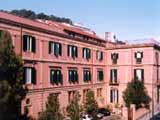 |
 |
The citadel |
The institute |
To respond the university community needs and renew all areas, renovation works started in 2000 involving the entire perimeter and monastery walls. The tender, financed by the UE was 6 million € worth and was awarded to the “Edil Atellana” from Casagiove, the project has been edited by the architect Renato Sparacio. Besides the demanding restructuring work, new constructions were planned and among them, an Aula Magna and a new general archive which are particularly remarkable by their dimensions and difficulty.
 |
 |
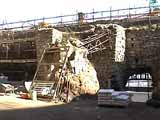 |
Putting in safe the old buildings |
Aula Magna with view
The new Grand Hall has a seating capacity of 400 people and has been completely dug into tufa. Considering the particularly awkward location of the jobsite, a high area almost totally occupied by the space to be built, digging materials have been removed through a pipe and then stocked at a lower level and brought to a dump with trucks. Digging had to be done necessarily with small equipment such as mini excavators or demolition hammers. The company met specific problems to convey concrete for walls and foundation. The concrete quantity to be pumped was quite big, it was thus impossible to use crane baskets to convey it. This system would have interrupted constantly concrete pouring and diminished the construction quality. The company decided to use a screw pump fed with crane baskets. The concrete pumps manufactured by Bunker from Casandrino (Naples) enable conveying large normal or cellular concrete amounts over long distances. They are compact enough to be used even in the difficult jobsite conditions mentioned above.
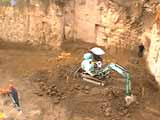 |
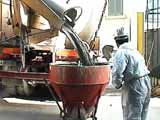 |
 |
The exacavation |
Filling the conveyor bucket |
The Grand Hall’s soil has been consolidated with micropiles, the latter have been used in other parts of the building (stairways) and have been reinforced with horizontal and vertical tie rods.The tufa blocks dug during the foundation phase were used to restore the quite deteriorated walls next to the stairway. This section of the wall perimeter had collapsed and has been recovered and consolidated by laying carbon fibre bands and a series of special anchoring ties and micropiles. Reinforced foundation works were done after terrain stabilisation and prepared the space for air conditioning systems. The tufa wall on the Grand Hall side facing the mountain will be exposed while the other side will have a large window with adapted darkening systems being designed to optimise the internal temperature and make it as little affected as possible by external conditions and keeping the view on the Gulf on Naples unobstructed.
Classrooms
All classrooms were renovated. In this case, deadlines were very short: from the day schools closed, July, the 20th until they opened on September, the 15th. It’s very short when you think the renovation works included the whole building. Phreatic humidity issues were solved, the use of some buildings have changed and safety levels have been incremented to meet modern school building standards.Indeed, it has been necessary to consolidate archs by inserting carbon fibre bands to increase their bearing capacities. The phreatic humidity issue proved to be difficult to solve, especially where wall thickness and depth (underground hillside locations meant that the humidity rose as high up to the vaults, which caused consequently effloresence and mould to appear). Solutions have been found : removing deteriorated plasters with mechanical systems like channel diggers and alike and applying dehumidifying plasters to the wall.
 |
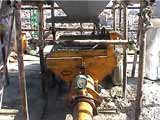 |
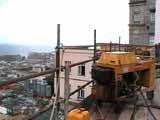 |
The conveyor bucket fills the silos |
The B100 fed by the silos |
The B100 power pack away from the pump |
Sanitary installations were as well completely rebuilt. After the building’s consolidation, all plasters and floors were restored with a particular attention to the complete restoration of all significant artefacts such as old wrought iron grids for the nun parlours.
Walls
Walls of the ancient monastery were dramatically deteriorated and completely cracked in some cases. It consisted in ensuring safety of existing walls and repair collapsed sections. The external surface was made using the same original tufa and selecting as close as possible sizes and colors as the existing ones.